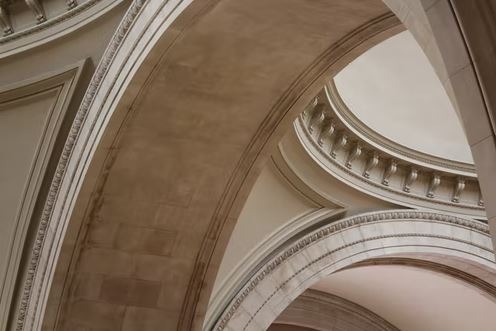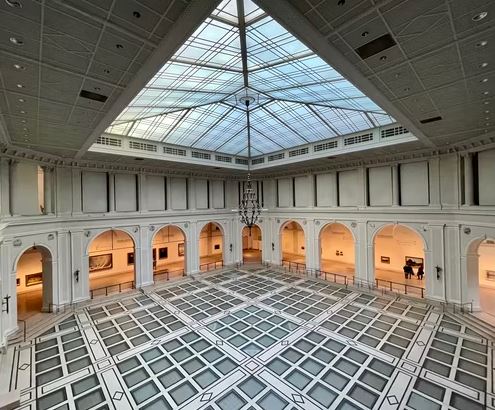In the Brooklyn neighborhood of New York City, there is an art gallery called the Brooklyn Museum. Among the top Museums to visit in New York, the Brooklyn Museum has the third-largest physical footprint in New York City at 560,000 square feet, or 52,000 m2, and has a collection of art that totals about 500,000 items.
The McKim, Mead, and White Beaux-Arts structure, built in1895 and close to the Brooklyn neighborhoods of Prospect Heights, Crown Heights, Flatbush, and Park Slope, was intended to house the largest art museum in the world. The museum initially struggled to preserve its structure and collection, but in the late 20th century, extensive renovations helped it to become rejuvenated. Antiquities, in particular its almost 3,000-year-old collection of Egyptian antiquities, are significant components of the collection. Important antiquities collections include works of art from Europe, Africa, the Pacific, and Japan.
Antiquities, its almost 3,000-year-old collection of Egyptian antiquities, are significant components of the collection. Important antiquities collections include works of art from Europe, Africa, the Pacific, and Japan. Starting with the Colonial era, there is a substantial representation of American art. The collection features works by Mark Rothko, Edward Hopper, Norman Rockwell, Winslow Homer, Edgar Degas, Georgia O’Keeffe, and Max Weber, among other artists. The museum has the Steinberg Family Sculpture Garden, which makes use of salvaged parts of New York City’s buildings.
About the Brooklyn Museum of Art
A museum of art, The Brooklyn Museum, also referred to as The Brooklyn Museum of Art, is situated in Brooklyn, New York. The Brooklyn Museum, the third-largest museum in all of New York City, houses slightly over 1.5 million works of art across hundreds of thousands of square feet, making it a popular tourist destination and one of the top museums in Brooklyn and NYC to visit. In addition, you can also check guides to the best art museums in New York City.
The artwork on display at The Brooklyn Museum reflects diverse world cultures and their aesthetic traditions. The African art, Egyptian art, and paintings from the 17th through the 20th centuries are what the Brooklyn Museum of Art is best known for. Among the well-known artists on show are Mark Rothko, Georgia O’Keeffe, Edward Hopper, Norman Rockwell, and Edgar Degas.
The Brooklyn Museum’s main goal is to broaden visitors’ horizons and perspectives on the globe. The Brooklyn Museum of Work is a fantastic destination to spend a day studying its permanent collections, temporary exhibits, and special programming if you want to see art that broadens your perspective on various periods of world history.
Brooklyn Museum History
The Brooklyn Apprentices’ Library in Brooklyn Heights was established in 1823 by Augustus Graham, and this is where the Brooklyn Museum had its start. In 1841, the Library relocated into the Brooklyn Lyceum structure on Washington Street. The institutes combined two years later to create the Brooklyn Institute, which presented exhibitions of painting and sculpture as well as lectures on a range of topics. Under Franklin Hooper, the Institute’s director, it was reconstituted as the Brooklyn Institute of Arts and Sciences in 1890, and construction on the Brooklyn Museum got underway. Up until the 1970s, the museum, together with the Brooklyn Academy of Music, the Brooklyn Botanic Garden, and the Brooklyn Children’s Museum, all belonged to the Brooklyn Institute of Arts and Sciences.
In 1960, Thomas S. Buechner was appointed director of the museum, making him one of the nation’s youngest directors. Buechner led a significant change in the museum’s art display practices and brought over a thousand pieces that had been languishing in the storage areas and put them on show. During that time, Donelson Hoopes was employed as the Curator of Paintings and Sculptures from 1965 to 1969. Buechner was instrumental in saving the Daniel Chester French sculptures from destruction as a result of an expansion project at the Manhattan Bridge in the 1960s.
Michael Botwinick succeeded Duncan F. Cameron in the position (1974–1982), and Linda S. Ferber served as acting director for a portion of 1983 until Robert T. Buck took over as director in 1983 and retained the position until 1996. Stephanie Stebich worked as an assistant director from 1992 to 1995. Shortly before Arnold L. Lehman’s tenure as a director began in 1997, the Brooklyn Museum changed its name to the Brooklyn Museum of Art. The museum announced to return to its old name on March 12, 2004. The James Polshek-designed entrance pavilion on the Eastern Parkway frontage was unveiled in April 2004. Lehman declared in September 2014 that he intended to retire in June 2015. The museum’s new director, Anne Pasternak, the president and artistic director of Creative Time, was appointed in May 2015; she began her duties on September 1.
The Brooklyn Museum’s construction
The Brooklyn Museum building was constructed by the Carlin Construction Company and has a steel frame with stone siding. It was designed in the neoclassical style by the architectural firm McKim, Mead, and White. The Brooklyn Museum’s original plan was for a building that was four times bigger than what eventually emerged between 1893 and 1927 when construction was completed. Support for the project declined once Brooklyn joined greater New York City in 1898. The main designer of the pediment sculptures and the 12.5-foot monolithic statues along the cornice was Daniel Chester French, who also created the monument of Abraham Lincoln in the Lincoln Memorial. The Piccirilli Brothers crafted the figures after they had been carved by 11 different artists. French also produced the two allegorical sculptures Brooklyn and Manhattan, which were first made in 1916 for the Brooklyn approach to the Manhattan Bridge and moved to the museum in 1963. They are currently flanking the entrance to the museum.
By 1920, the New York City Subway had a station that connected to the museum, considerably enhancing access to the formerly cut-off institution from Manhattan and other surrounding boroughs. Franklin Hooper, the director of the Brooklyn Institute, served as the museum’s first director. He was succeeded by William Henry Fox, who led it from 1914 until 1934. Charles Nagel, Jr. (1946–1955), Edgar Craig Schenck (1955–1959), Laurance Page Roberts (1939–1966), Isabel Spaulding Roberts (1943–1966), and Philip Newell Youtz (1934–1938) came after him.


